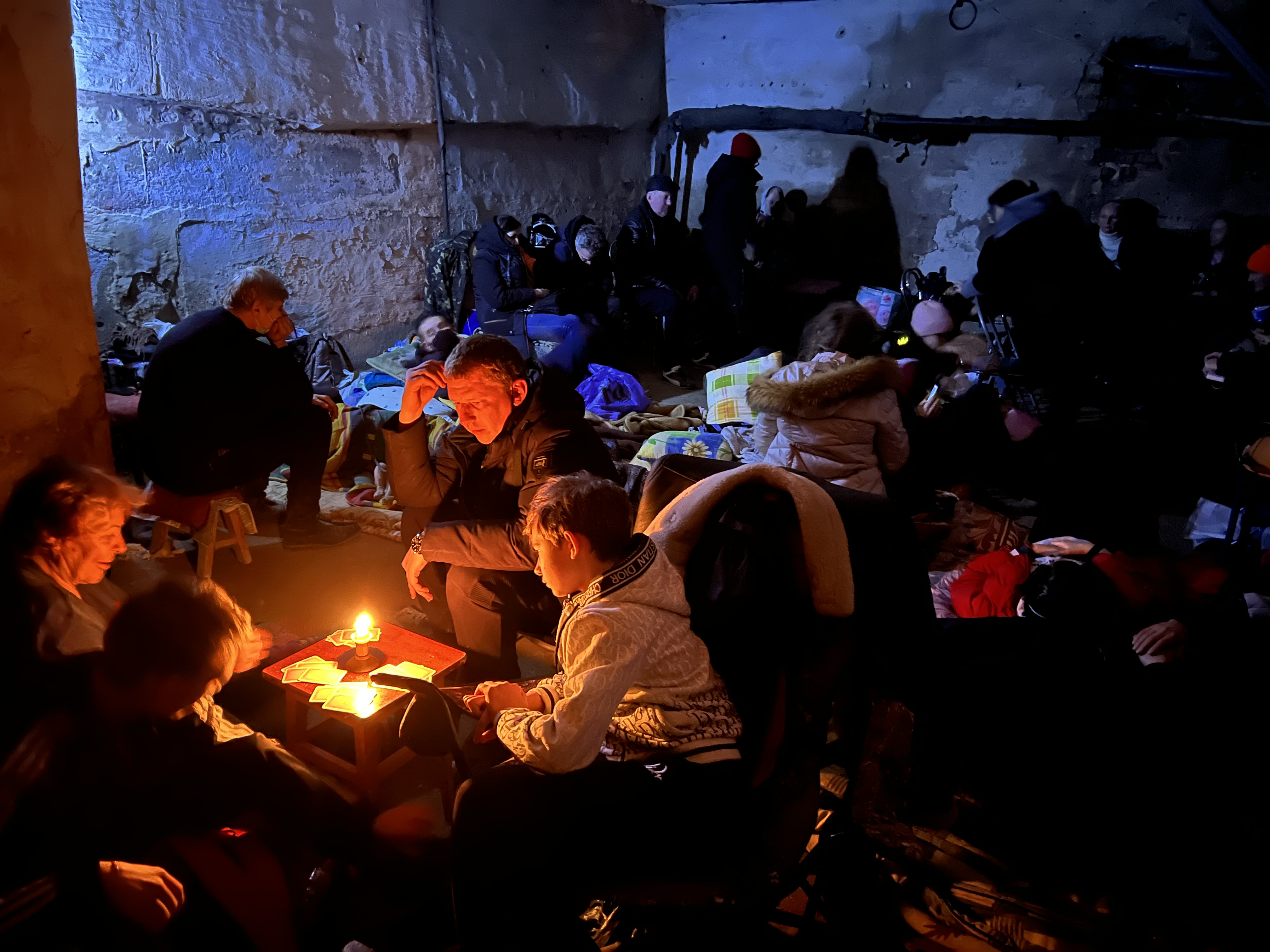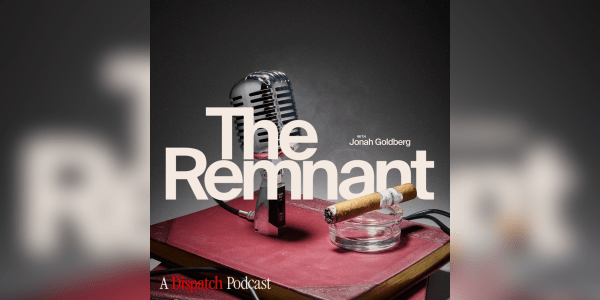In March the ground in Eastern Ukraine was too frozen to dig graves, so survivors of Russian bombing draped blankets over corpses rather than properly burying their dead. It’s not something that Igor Khatuntsev, 45, then a Mariupol resident, can forget. “People were dying right in front of our eyes,” he told The Dispatch through a translator. “Children, adults …”
He and his wife Marina, 43, now live in Illinois. But the weeks they sheltered underground with their three sons, living in fear of indiscriminate bombing, don’t feel far away. “Shelling was coming closer and closer,” Marina Khatuntsev recalled. “You’re kind of in this constant state of fear and prayer.” The shelling pitted the ground with holes that they eventually began using for burials.
With the ground still frozen in Mariupol, President Joe Biden announced in March that the United States would admit some 100,000 Ukrainians and family members fleeing Russia’s invasion. The U.S. has exceeded that benchmark, welcoming the Khatuntsevs and another 130,000 Ukrainians through various legal pathways, according to the Department of Homeland Security (DHS).
But the administration’s reliance on pathways other than the traditional refugee process has provoked concern and criticism. Many Ukrainians struggle to get permission to work and their legal status may soon expire.
“Ukraine is a different situation than a lot of other refugee crises in that a significant share of the population had tourist visas” at the outset of the conflict, Matthew Soerens of World Relief, said in an interview. His organization is one of the nine refugee agencies that carry out settlements alongside the government.
Ukrainians on temporary visas can seek asylum—a protective status conferred to foreigners who meet the international legal definition of a refugee—but a significant backlog means they could wait years for an answer. And only 861 Ukrainians came through the traditional refugee resettlement program between February and July, the latest month with available data. Soerens added that those who had applied were likely already in the pipeline before the invasion began.
The Khatuntsevs’ oldest son and daughter-in-law came into the United States at the U.S.-Mexico border in April and began the process to seek asylum.* Nearly 25,000 Ukrainians did the same between February and July, according to U.S. Customs and Border Protection data. The Biden administration has since discouraged those fleeing the war from doing so, and directed them to use the streamlined process Uniting for Ukraine offers.
In April Igor, Marina, and their three younger sons came through the Uniting for Ukraine program, which weds a private sponsorship model with a legal status known as humanitarian parole: An individual already in the United States can apply to sponsor the resettlement of Ukrainians. If the sponsorship goes through, Ukrainians are then allowed into the United States and granted humanitarian parole status by the DHS.

Around 46,000 Ukrainians have come via the program, with an additional 81,000 approved as of August 31, according to the DHS. Refugee advocates and congressional aides praise the program for its nimbleness, but it comes with downsides.
A pastor helped the Khatuntsevs settle in Wheaton, Illinois. The family joined a local evangelical church with a large Ukrainian-Russian speaking congregation, which alongside the refugee resettlement agency World Relief has helped make up their safety net. Months after arriving, Igor, who worked in the coal industry, is still waiting for his work authorization and Social Security card. “Not being able to work makes it really hard,” he said. “Nobody wants to rent apartments to Ukrainians.”
Days after the invasion, the European Union—which has accepted more than 7 million refugees from Ukraine, according to the United Nations refugee agency—granted Ukrainian refugees the right to live and work in the bloc. Yet the U.S. has moved at a relatively glacial pace. Unlike refugees, who are granted work authorization along with their status, parolees in America have to apply separately once they are in the country. U.S. Citizenship and Immigration Services (USCIS) can take up to 10 months to grant work authorization, though Soerens observed some cases have been approved within two months.
The other sticking point is that parole status is inherently temporary, lasting only two years. The Biden administration announced that Ukrainians who arrived prior to April 19 can apply for Temporary Protected Status, another designation allowing recipients to live and work in the country. But how long that protection lasts is up to the White House, and no one knows what Ukraine will look like two years from now.
“We have real concerns that there might be a growing trend of an over-reliance on humanitarian parole, which is not a fix-all,” Naomi Steinberg, vice president of policy and advocacy at HIAS, another government refugee resettlement partner, told The Dispatch. “The need is for improvement to the U.S. refugee resettlement program, not becoming complacent with using humanitarian parole.”
Congress isn’t thrilled with the trend either. “The U.S. has a long-standing formal refugee program that has worked well,” a congressional aide said. “The concern by some members of Congress is that the system is not being used.” The staffer added that “regular refugee processing is not proceeding as planned.”
Biden campaigned on prioritizing refugee resettlement, but the administration hasn’t met expectations set in 2020: It’s unlikely that the U.S. will hit its refugee ceiling target of 125,000 for this fiscal year, which ends September 30. However, parolees admitted don’t count toward the refugee ceiling as that program is separate from refugee admissions. The United States has only admitted 17,690 refugees, according to the Bureau of Population, Refugees, and Migration’s (PRM) most recent report.
“The Department will continue processing additional Ukrainians fleeing Russia’s unprovoked invasion in the weeks and months to come, consistent with the President’s commitment,” a DHS spokesperson said in a statement.
After two months of desperate fighting, Mariupol fell to Russian forces in April, not long after the Khatuntsevs managed to escape. Local officials estimate more than 20,000 civilians died, and less than a quarter of the pre-conflict population remains. Mariupol has now taken a place in history alongside Aleppo, Grozny, and other cities destroyed by the brutality of Russia’s military.
Many refugees admit they long to someday return home, but for Igor and Marina there isn’t a home left to return to. The question is whether America’s refugee policy can keep up with that reality.
*Correction, September 6, 2022: The Khatuntsevs’ oldest son and daughter-in-law were not granted asylum when they entered the United States.






Please note that we at The Dispatch hold ourselves, our work, and our commenters to a higher standard than other places on the internet. We welcome comments that foster genuine debate or discussion—including comments critical of us or our work—but responses that include ad hominem attacks on fellow Dispatch members or are intended to stoke fear and anger may be moderated.
With your membership, you only have the ability to comment on The Morning Dispatch articles. Consider upgrading to join the conversation everywhere.